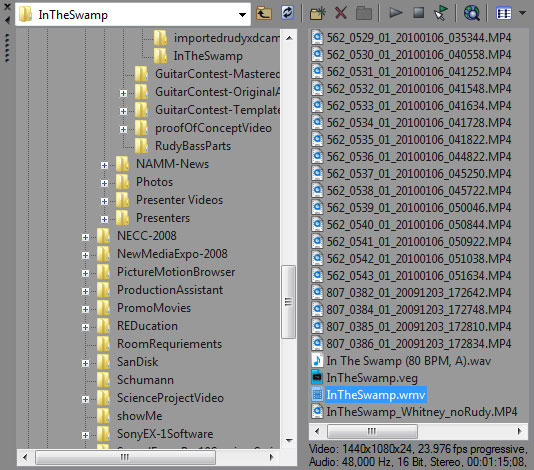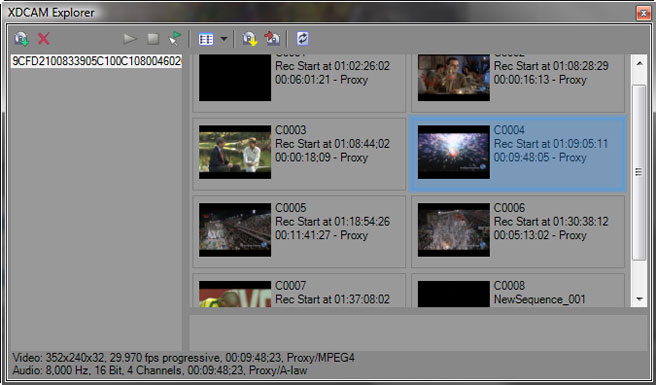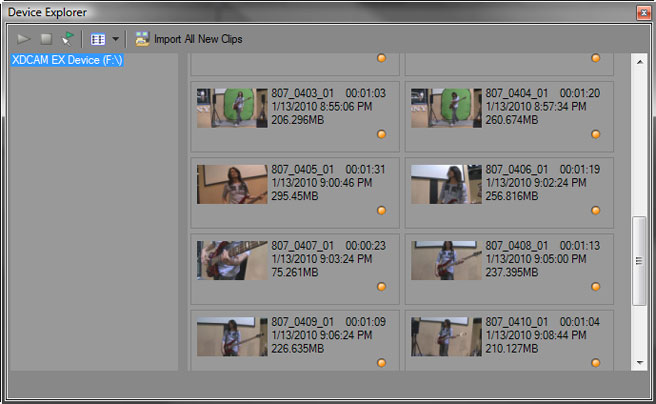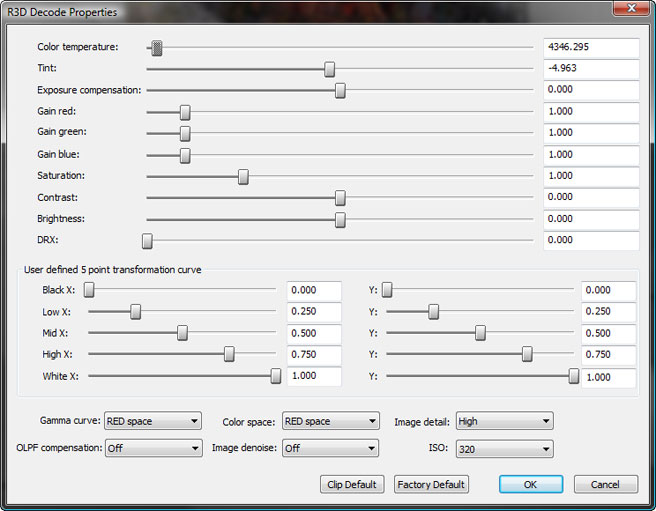Working with a variety of video file types in Vegas Pro
by Gary RebholzOver the years, Vegas Pro software has been a pioneer and true innovator while other NLE manufacturers play catch-up. Take, for example, their "coming soon" support for 64-bit operating systems. While their customers long to work in 64-bit projects "someday," Vegas Pro users have been taking advantage of the power of a true 64-bit environment since we first introduced our support with the release of Vegas Pro 8.1 in 2008!
Similarly, Vegas Pro has always featured robust native file format support. From the beginning around 10 years ago, Vegas Pro users have enjoyed the ability to throw just about anything at their projects with the confidence that the application would simply accept it and enable them to get on with their work. We've always put a premium on the ability for Vegas Pro software to work with native codecs and file formats as they come off of the recording media instead of forcing users to transcode or re-wrap their footage to a single edit-friendly format. With every format that Vegas Pro software supports and has ever supported, you can mix and match all the frame sizes and frame rates on a single timeline, in most cases without transcoding or re-wrapping your files. To the user, that means simplicity. Just throw it on the Vegas Pro timeline and start editing.
In this article I present an overview of many of the major file formats as they relate to Vegas Pro software. This will give you a good idea of the flexibility you have to work in Vegas Pro projects regardless of the cameras you shoot with or the type of files you use in your work. This flexibility gives you many more options when it comes to deciding what video cameras to buy. It also enables those of you who work with files provided by other sources to accept more jobs. I'm going to focus on video file types, but don't forget the huge array of audio file types, like WAV, AIFF, MP3, FLAC, and more that the application handles with ease.
In a great generality, Vegas Pro software supports video files that fall into three categories:
- Files that work right out of the box
- Files that work after you install a free codec
- Files that work after you purchase and install a codec

You can use the Explorer window to navigate to any video
file that's already on your local or network drives.
If you have DV or HDV on tape that you haven't yet transferred to your hard drive, you can use the Vegas Pro video capture tools to transfer it. To capture from tape, choose File | Capture Video. In the Capture video dialog box, select either the DV or the HDV radio button and click OK. The Sony Video Capture application opens for DV capture or the integrated video capture window opens for HDV capture. Use the capture utility's controls to find and capture the footage you want. When you're done, close the capture utility and click the Project Media tab to see that the clips have automatically been added to your project.
You might also be shooting your DV or HDV footage to the DR60 hard-disk recording unit or the MRC1K memory recording unit. If so, you can easily import that footage from either of those storage devices into your project.
Choose File | Import and from the cascading menu, choose either Hard Disk Recording Unit or Memory Recording Unit. Again, when you're done with the file transfer, the clips appear in your Project Media window ready for you to use. For a thorough walk-through of HDV video capture or importing, check out the free Working with HDV in Vegas Pro tutorial video.
You can also use the Import process to transfer MPEG-2 files from your direct to DVD video camera into your Vegas Pro project. Connect your camera and choose File | Import | DVD Camcorder Disc. Again, the processes finishes with the clips loaded into your Project Media window.
Vegas Pro software features intuitive workflows for working with several of the exciting newer file formats as well. For instance, the application's XDCAM workflow has been praised as straight-forward and complete. To pull your MXF footage from an optical XDCAM disc (or from a disc image that you've copied to a network or hard drive), choose View | XDCAM Explorer.
The XDCAM Explorer window, shown in Figure 2, provides tools you use to import the proxy and/or full-resolution video files from your disc. You can complete your entire edit with the proxy files in order to lighten the load on your CPU and then swap them out for the full-resolution files when you're ready to deliver your project. You can also make use of your essence marks, shot lists, and more. For a full understanding of the XDCAM Explorer window, view the XDCAM workflow video tutorial series.

The XDCAM Explorer window gives you all the tools you
need to preview and import proxy and/or full-resolution clips from your
XDCAM optical discs, add the files to your project, and render an MXF
file back to your optical disc when you're done editing.
Finally, for several formats Vegas Pro software features the Device Explorer window. This window enables you to navigate to your device, preview the clips on that device, and import any or all of them–in their native format–onto your hard drive and into your project. Or, if you've already copied your disc image to a network or hard drive, you can import the files into your project from that location.
You can use the Device Explorer window for several different file types including XDCAM EX MP4 files, AVCHD from several cameras including the new Sony HXR-NX5U and HDR-AX2000 NXCAM camcorders, and R3D files from your RED camera. And as I mentioned, Vegas Pro software supports each of these formats natively so you know you're working with the best quality possible right from the cameras.
To use the Device Explorer, first, connect your device. Choose View | Device Explorer. Each device you have connected to your computer appears in the left-hand pane of the Device Explorer window. You can also browse to any disc image that you have stored on a network or hard drive. Select the device from the list to view thumbnails of the clips on that device in the right-hand pane as in Figure 3. Select a clip and click the Start Preview button to view it. Drag the clip to your timeline to simultaneously import it onto your hard drive and add it to your project. To add several clips at once, select each of them and click the Import Selected Clips button. Or, to import all of them, click away from any clip to deselect them and click the Import All Clips button.

Use the Device Explorer window to preview XDCAM EX
files, RED ONE files, and AVCHD files, import them to your computer
drives, and add them in their native formats to your project timeline.
Vegas Pro provides further support for R3D files. Add an R3D file to the timeline, right-click the event and select Choose in Project Media List from the menu. Then, in the Project Media window, right-click the selected clip and choose File Format Properties from the menu. In the R3D Decode Properties dialog box you have access to all of the R3D Decode Properties. When you're done with your adjustments, click OK.

The R3D Decode Properties dialog box gives you control
over the same settings as those on the camera.
For complete information on both the Device Explorer window and the complete RED camera workflow, check out the Vegas Pro 9 Seminar Series training package.
The second group of file types that Vegas Pro software supports includes files that require the installation of free third-party video codecs. If you add a file to your timeline and you get the audio but no video, that's usually a good indication that you need to install a codec. This category includes a wide variety of file types but a few important ones stand out.
First, if you're receiving files from a colleague who works on a Mac, you may well be faced with using ProRes MOV files in your project. You can download the ProRes codec from the Apple site and install it on your machine. Once you've done so, use the Vegas Pro Explorer window to navigate to where you've stored your ProRes files and drag them to your timeline. Once again Vegas Pro software utilizes the ProRes files in their native format.
Somewhere around build 7.6.2 or so, Apple also began including the ProRes codec with their QuickTime player. So if you have already installed the player, you can use ProRes files on the Vegas Pro timeline without any further codec installation.
DNxHD files from Avid are similar to ProRes files and they work the same way. Download and install the free codec from the Avid site and you can add DNxHD files to your Vegas Pro timeline from the Explorer window.
Finally, like us, many of you use Techsmith's Camtasia screen capture software to create software demos or training. To edit the AVI files from Camtasia on the Vegas Pro timeline, you'll need the TSCC codec. If you've installed Camtasia, then you already have the codec, but if you're editing on a machine that doesn't have the application, you can download the TSCC codec from the Techsmith website. Then use the Vegas Pro Explorer window to navigate to your Camtasia files and add them to your project timeline.
The last category includes files that also require the installation of third-party codecs, but these are available from their manufacturers only by purchase. Chief among this group are codecs that enable you to use files that have been wrapped by a different application into another format (for example, MOV files that were created by wrapping HDV files, MP4 files shot with the XDCAM EX, or MXF files shot with XDCAM). Some of these codecs also enable you to work with files such as all popular flavors of DVCPRO50 and DVCPRO-HD files from the Panasonic P2 camera, and MOV files created by certain JVC cameras. Codecs in this group include the Raylight family of codecs from DVFILM.com (including future support for AVC-Intra through Raylight Ultra), Calibrated XC Decode from Calibrated Software, and the neohd product from Cineform.
Each of these products is for sale, so you'll want to do a bit of research before you buy to make sure you're getting the right one for the work you need to do.
The robust file format support that we've talked about in this article means more flexibility for Vegas Pro editors. While the software is certainly more thoroughly optimized for some of these formats than others, it's essential to your business to know that you can accept formats that fall outside of your normal workflow and integrate them into your Vegas Pro projects.



Комментариев нет:
Отправить комментарий